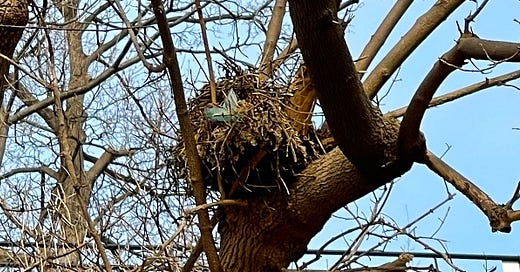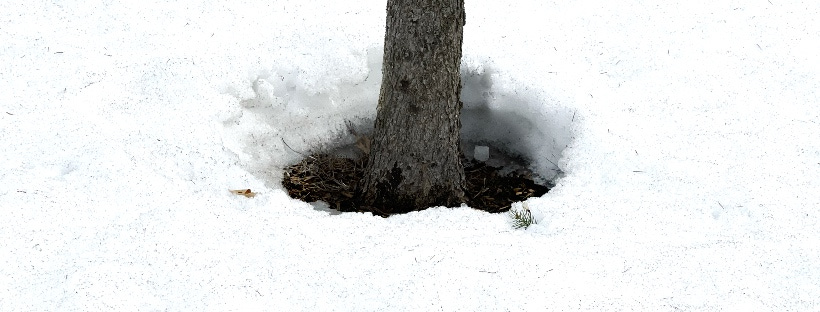One of the pleasures of an early morning walk is that it is so quiet. There are no cars on the road; there is less noise and, in this season, less dust. In the long Canadian winter, crushed stones are thrown on the roads to ensure that the car tires keep a good grip. If you live in a warm country, you may never have thought of this, and I believe that many people living in a colder climate may never have given this much thought either. But some clever people have done quite a bit of thinking to work out what exactly needs to be used. The particles may not be too small because then they will easily be blown away, or they might disappear in the snow. But if they are too big, they risk breaking your windshield. To complicate things further, the kinds of pavements are also relevant, and so is car speed. Highways require a different treatment than local roads. Only an expert can decide on the right mix of crushed stones and gravel to provide that extra traction on icy roads.
There is a lot to learn and experience when you move to a new country. During this morning's walk, I heard birds singing more enthusiastically than in the previous days. They must know what I learned from my weather app: tomorrow, it will be 18 degrees Celsius (64F) while there are still piles of snow everywhere. I realized how many of these bird sounds I had never heard before in Europe or elsewhere.
BirdNet
Help came from Doug. He is a 'Twitter friend,' one of the many that I have worldwide, and shares a wealth of knowledge about Ontario's nature. He told me about the BirdNet project from the Cornell University Department of Ornithology. They trained computers to identify nearly 3,000 of the most common species of birds in North America and Europe.
Once they had worked that out, they created an app that is easiest described as the Shazam for bird sounds. It analyses your recording in their huge database and instantly tells you which bird you just listened to. A great app for you, but you also help them collect observations by submitting your recordings when you use it. I just downloaded their free app on my phone and look forward to trying it soon. Search for 'BirdNet' in your app store. This video shows you how it works. (It says in the beginning that it is not yet on iOS, but since then, it has been made available for both Android and iOS)
I would love to hear if this app works for you and which birds you have found.
We are not the only ones to embrace new technology. City birds are known to make use of our products creatively. I found this bird nest in the center of Ottawa. It is partly constructed by plastic waste and a covid-mask. It is a sad sight to see, but I admire the bird. It promotes the circular economy while protecting itself against bird flu.
After a long winter, the change to spring happens fast in Ottawa. The birds seem to know it, but the rest of nature is also conditioned to maximize the half-year on non-winter conditions. It is fascinating to follow while the layers of snow haven't even fully melted. I noted that trees speed up the melting. Have a look at this picture.
The darker the tree, the bigger the circle they make in the snow. A bit further down the road, I saw a birch tree that was still fully snowed in. It stood next to what I believe was a darker beech tree that was clearly the winner; it had collected enough heat to create a snow-free island. This reminded me of the melting in the Arctic and the best known of the several positive feedback loops at play in the high north because of climate change. The sea-ice reflects the warming sunlight, but it retreats due to global warming. The sea area thus increases, which has a lower, darker albedo (a measure of the solar reflection), and this results in more warming.
Beech bark disease
Those beech trees may beat the birch trees in melting snow, but they have worries of their own. Many are under attack from an insect introduced from Europe at the end of the 19th century, killing them in three to five years. Experts are on the lookout for resistant trees that may lead to a solution to fight this problem. Like the BirdNet, they could use your help at Beech Bark Disease Resistance to inform them when you find a beech tree of at least 20-30 cm (8-12 inches) in diameter that appears healthy and free of beech scale, while trees around are dead and dying of the disease. It may be a resistant tree that the American beech breeding programs can use. You can have a look at their website; they will welcome your help.
That's it for today. That was my morning walk. I hope you will spend some time in nature today, even spending time in a small city park can make you feel better.
Could you think of five friends that could be interested in following The Planet newsletter? Perhaps you could inform them about this new initiative. I would be happy to see more sign-ups for the free newsletter or monthly or annual subscriptions.









Hi Alexander, this morning I missed the bird songs, it was the garbage truck with the 'warning beep' backing-up that woke me. Still better than an alarm clock! But I hope in future days that these trucks are needed less and less. . . (-:
I would love to follow the birds and capture their sounds and pictures.
It's time for a smartphone purchase, (I'm a 'pay-as-you-go' phone user now) so that I can help add bits of real time events to Databases. Already feel more useful with that in mind (-:
I like the thought of tree reading as a skill to be enjoyed also. This is what I'm aware of, for example mosses have a tendency to grow on the 'north side' of their trunks. In the Southern Hemisphere it's a different story. Thank you
Hello Alexander - great article! My name is Justine Ammendolia and I am a scientist based out of Toronto. I am recording interactions with wildlife and PPE debris and came across a photo you took in this article. I was wondering if I can ask some questions about your sighting? Please feel free to contact me through Facebook or my email: jammendolai@mun.ca